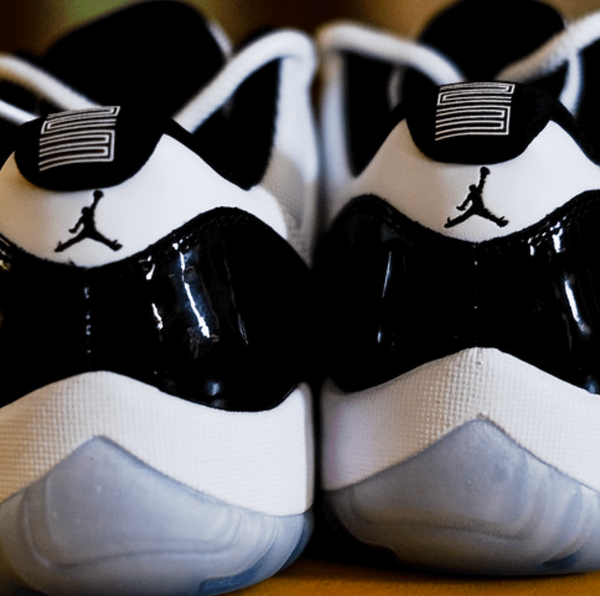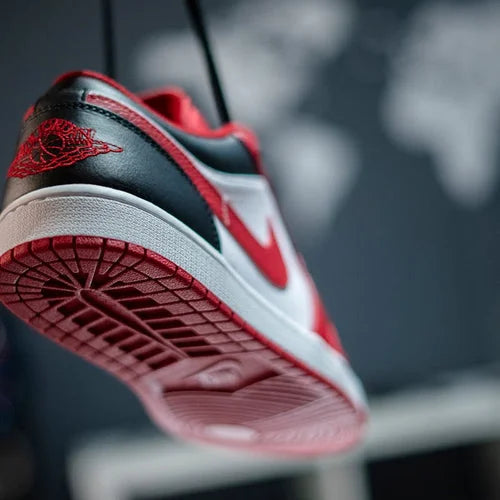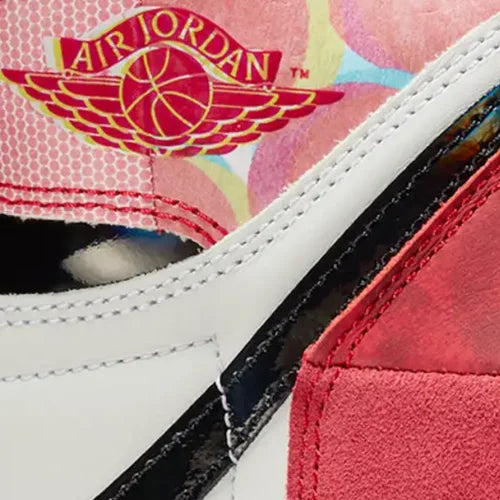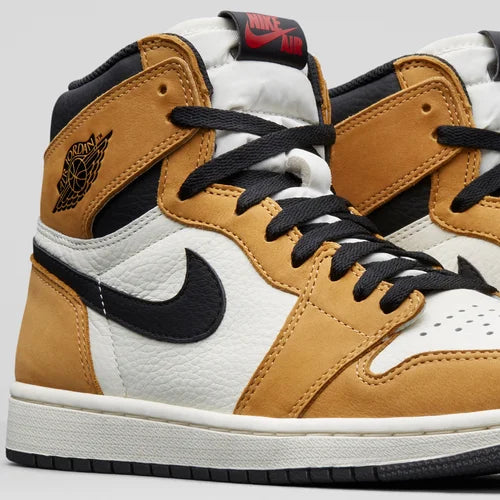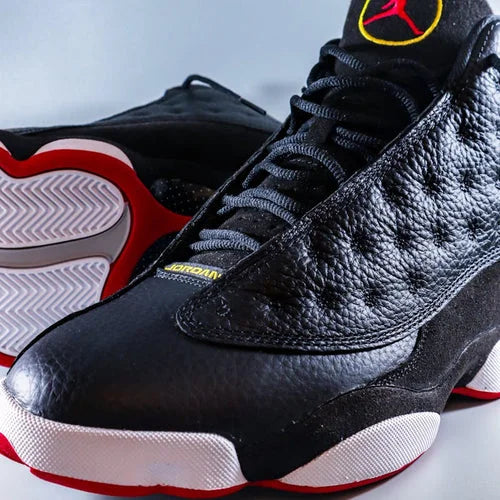How to Tell if Jordan 9s Are Fake

Counterfeit sneakers abound in the market, posing challenges for renowned brands like Nike, Adidas, Reebok, and Puma.
Buyers are keen to avoid spending their money on fake products. In this comprehensive guide, we aim to assist you in navigating the realm of sneaker authenticity, with a particular focus on Jordan 9s.
Covering essential elements such as the shoe box, Jumpman logo, and shoelaces, we provide insights to help you differentiate between authentic pairs and replicas.
Stay well-informed and confident as you verify the authenticity of these iconic sneakers.
Table of Contents
[ open ]Overall Check

When checking if Jordan 9 sneakers are real, look at everything. Check how they overall look, the materials used, and if the logos are in the right places. Look at the shoe box - the branding and labels should be consistent.
Also, examine the laces - they should feel right and be the correct color. Check the size tag for accurate information. Look at the Jumpman logo - it should be the right size and in the right place.
Lastly, check the tongue for good stitching and proper logo alignment. This thorough examination helps you know if your Jordan 9s are real or fake.
Shoe Box
When it comes to authenticating Jordan 9 sneakers, one crucial method involves a meticulous examination of the shoe box. This method provides a comprehensive check by focusing on branding, labeling, and specific details presented on the box.
Branding and Labeling Consistency
Real Jordan 9s have a neat and clear shoe box with accurate logos and labels, giving them a polished look. But fake Jordan 9s might have issues like uneven printing, spelling mistakes, or logos in the wrong places on the box.
Inconsistent Printing and Misspelled Words
When using the shoe box method, focus on the printing quality and spelling. Legit pairs have precise printing and accurate spelling, enhancing the overall look. Counterfeit ones might show inconsistencies like uneven printing or misspelled words, indicating they could be fake.
Logo Placement Accuracy
Check the logo placement on the shoe box to tell if Jordan 9s are real. Real ones have logos in the right spots, creating a well-designed box. Fakes, however, might have logos in the wrong places, showing they're not genuine.
Manufacturing Sticker and Style Number
To ensure a complete authentication, check for a manufacturing sticker on the box's outside. Legit Air Jordan boxes have an official sticker with details like style name, size, color, and country of manufacture. The sticker should be firmly attached, with uniform spacing and correct spelling. Counterfeit Jordans may have misshapen or crooked stickers, serving as authenticity red flags.
Confirming the Nine-Digit Style Number
Verify the nine-digit style number on the manufacturing sticker for added authentication. Legitimate Jordans have this number below the country of manufacture. Buyers can cross-check it on the Nike website to confirm authenticity.
Size Tag
When verifying the authenticity of Jordan 9 sneakers, two essential steps involve scrutinizing the size tag and examining the label under the tongue. These methods offer critical insights into the genuineness of the sneakers.
Size Tag Examination
When checking if Jordan 9s are real, focus on the size tag. Genuine pairs have a clear and well-printed size tag with accurate details like the date of manufacturing and origin. Yet, counterfeit versions might show differences like thick or misaligned printing, errors in "MADE IN" info, or inconsistent fonts. By carefully examining the size tag for accuracy, buyers and enthusiasts can spot potential fakes, making it a reliable method for authentication.
Tongue Label Inspection
Check the label under the tongue; it's a crucial step. Jordans have a unique label there, saying "greatest player ever." The embroidery should be white, easy to read, and look professional. If you spot irregularities like color changes or messy stitching, it could be a sign of fake Jordans. Lifting up the tongue and inspecting this label helps buyers and enthusiasts confirm the authenticity of Jordan 9 sneakers.
Jumpman Logo

When checking if Jordan 9 sneakers are real, focus on the Jumpman logo. Real pairs have a carefully crafted logo with the right proportions and clear features.
On the flip side, fake Jordan 9s may show issues like an uneven or unclear Jumpman, messy stitching, or inconsistent placement.
Watching out for these details is a dependable way for enthusiasts and buyers to tell genuine from fake Jordan 9s. It ensures a confident and informed judgment about the sneaker's authenticity.
Toe Box

Check the toe box to tell if Jordan 9 sneakers are real. Genuine pairs have a unique shape with precise stitching, adding to their distinct look.
On the other hand, fake Jordan 9s might show irregularities like uneven shapes, inconsistent stitching, or differing details.
Watching the toe box is a practical way for enthusiasts and buyers to spot potential fakes. By focusing on these specific features, individuals can judge the authenticity of Jordan 9 sneakers and make informed decisions when buying or verifying their pairs.
You May Also Like: How to Spot Fake Jordan 3s
Sole Pattern

When differentiating real from fake Jordan 9s, pay close attention to the midsole. This is the point where the side fabric transitions into the front of the shoe, usually featuring a distinct fabric and color from the toe section. On authentic Jordans, the midsole point aligns in front of the bottom lace hole.
However, on fake Jordans, the midsole point often matches the bottom lace hole, revealing a potential inconsistency.
Additionally, examine the midsole tips; genuine pairs have sharp tips on the sole molding, resembling "mountains," while fake versions may have curved edges.
This detailed inspection ensures enthusiasts and buyers confidently assess the authenticity of Jordan 9 sneakers, making well-informed decisions.
Rear Shoe

Checking the back of Jordan 9 sneakers is essential for verifying authenticity. Real pairs have specific details at the rear, like accurate stitching, logo placement, and proper alignment.
On the other hand, fake Jordans 9 might show irregularities, such as uneven stitching, misplaced logos, or variations in construction.
The rear shoe method offers a simple way for enthusiasts and buyers to spot potential fakes.
By closely examining the craftsmanship and details at the back of the shoes, individuals can confidently tell the difference between genuine and counterfeit Jordan 9 sneakers.
Read Next: How to Tell Real vs. Fake Jordan 4
Watch Out for Sneaker Scams
Here's how you can protect yourself from internet scams while shopping for a new pair of Jordan 9s.
- Step 1: Be cautious if new Air Jordans are priced under $100. Authentic pairs, especially limited editions, rarely drop below retail. If it seems too good to be true, it probably is.
- Step 2: Check for the "100% Authentic" label; avoid shoes labeled as "custom," "sample," or "variant." Always ask for the style number if not included.
- Step 3: Ensure shoes come with the right box, featuring accurate colorway descriptions and matching style numbers. Avoid buying if the shoes lack a box.
- Step 4: Be careful with online purchases; ensure clear and detailed images, including the interior tag with the style number. Avoid small or stock photos.
- Step 5: Avoid buying Air Jordans from overseas sellers; most fakes come from Asia, especially China. Purchasing from Asia increases the risk of getting counterfeit Jordans.
Frequently Asked Questions
Here are the answers to some of the most popular questions on the web
When did Jordan 9 come out?
Jordan 9, a significant addition to the Air Jordan lineup, was released on November 1, 1993.
Did Jordan wear Jordan 9 in-game?
Despite its initial release during Michael Jordan's temporary retirement from basketball, he returned to the NBA wearing the Jordan 9 during the 1993-1994 season.
Who designed the Jordan 9?
The design of the Jordan 9 was a collaborative effort, led by Tinker Hatfield.
Conclusion
In conclusion, the Jordan 9, introduced in 1993, holds a special place in the sneaker world and in Michael Jordan's career.
Worn during his comeback to the NBA, its design, led by Tinker Hatfield, reflects innovation and style.

